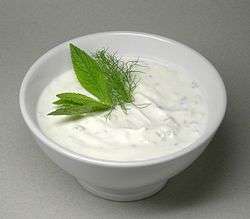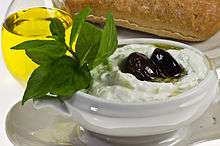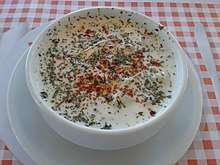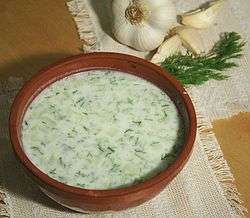Tzatziki
 | |
| Type | Dip or soup |
|---|---|
| Course | Appetizer, Side dish, Meze |
| Place of origin | Ottoman Empire |
| Serving temperature | Cold |
| Main ingredients | Strained yogurt, cucumbers, garlic, olive oil, salt, sometimes lemon juice, dill, mint, or parsley |
| Variations | With strained or diluted yoghurt and other herbs and vegetables |
Tzatziki, cacık or tarator is a dip, soup, or sauce found in the cuisines of Southeast Europe and Middle East. It is made of salted strained yogurt or diluted yogurt[1] mixed with cucumbers, garlic, salt, olive oil, sometimes with vinegar or lemon juice, and herbs like dill, mint, parsley and thyme.[2][3][4] It is generally served as a cold appetizer (meze) or a side dish.
Etymology
The Greek word tzatziki (τζατζίκι) comes from the Turkish word cacık.[5] According to Olga Razuvajeva, the word comes from the Armenian cacıg.[6]
The root cac is likely related to several words in Western Asian languages. Persian zhazh (ژاژ) refers to various herbs used for cooking. Evliya Çelebi's 17th-century Seyâhatnâme travelogue defined cacıχ (cacıg) as a kind of herb that is added to food.[7] Ahmet Vefik Pasha's 1876 Ottoman Turkish dictionary defined cacık as an herb salad with yogurt.[7] This remains the most common definition today.[1]
The form tarator is found in languages from the Balkans to the Levant, and appears to be of Slavic origin, coming from Bulgaria.[8][9]
Variations
Greece

Greek-style tzatziki sauce is typically served as a side with meat dishes; for example, it can be served with spiced chicken and vegetable couscous.[10] It may also be served as part of an assorted meze small plate platter that is traditionally served with the anise-flavored liquor called ouzo.
Tzatziki is made of strained yogurt (usually from sheep or goat milk) mixed with cucumbers, garlic, salt, olive oil, and sometimes lemon juice, and dill or mint or parsley.[4] Some variations are made with cattails or purslane, tofu, dill, and seasoned with Vege-sal and either whole allspice or spicebush berries.[11]
Purslane is called glistrida in Greek and this may be called glistrida me yiaourti meaning "purslane and yogurt salad" rather than tzatziki. One simple recipe calls for purslane, olive oil, red wine vinegar and dill.[12] Another is made with purslane, mint, cilantro, parsley and ground coriander, along with the standard yogurt-cucumber base.[13]
Turkey

Turkish cacık is made by combining a bit of water and yogurt in a deep bowl together with garlic and different combinations of fresh vegetables and herbs. The amount of water used depends on how thick the cook wants the cacık to be—sometimes the dish is served as a cold soup, but it can also be made thicker according to taste. Labneh may be substituted for some of the yogurt.[14] Garlic is crushed in a mortar and pestle together with salt and the cucumbers are either chopped or grated.[15] The crushed garlic, yogurt and cucumber are combined thoroughly before the dish is garnished with some combination of aleppo pepper, paprika, sumac or mint. It is especially popular during summer months and may optionally be served with ice.[16]
When shredded carrots are added along with the cucumber it is called havuçlu cacık.[17] In Turkey tarator is also called balkan cacığı and is made with fresh scallions and mint.[15] Other cacık varieties may include shredded radish[18] or chopped red pepper and fresh parsley. Dill can optionally be added as well.[19] Some recipes add fresh basil or a tablespoon of vinegar.[16][20] One version with basil is made with made with ground walnuts, hazelnuts and chopped fresh basil.[21]
Not all cacıks are made with shredded cucumber—sometimes various types of leafy greens or herbs are used in combination with other ingredients. For example, one version calls for boiled wheat berry (the same kind used to make Noah's Pudding) and fresh dill.[22] It can also be made into a type of salad with purslane.[23] Sometimes it is made with unripe (green) almonds called çağla in Turkish.[14] It may be also made from wild edible plants like çıtlık and eaten in a wrap called dürüm.[24][25]
For cacıklı arap köftesi, kofta made from a mix of bulgur and ground meat is served over cacık. In this case the cacık is made with chard rather than the usual cucumber. (Spinach or parsley may be substituted for the chard. Some recipes use purslane.)[26][27] Bulgurlu madımak cacığı is made with cracked wheat, cucumber and a type of knotweed called madımak.[28]
Balkans

There are dishes similar to tzatziki called tarator in many Balkan countries. Tarator is more often prepared as a cold soup, popular in the summer. It is made of yogurt, cucumber, garlic, walnut, dill, vegetable oil, and water,[29] and is served chilled or even with ice. Local variations may replace yogurt with water and vinegar, omit nuts or dill, or add bread. The cucumbers may on rare occasions be replaced with lettuce or carrots.
The thicker variation more similar to Tzatziki is sometimes known as "dry tarator" , or as "Snezhanka" salad (салата "Снежанка"), which means "Snow white salad", and is served as an appetizer or side dish. During preparation, the yogurt is hung for several hours in a kerchief and loses about half of its water. The cucumbers, garlic, minced walnuts, salt and vegetable oil are then added.
In Bulgaria,[30] Tarator is a popular meze (appetizer), but also served as a side dish along with Shopska salad with most meals. Sunflower and Olive oil oil more commonly used, and walnut is sometimes omitted. Tarator is seasoned with garlic and dill, both of which can be omitted. It's a popular dish in Bulgaria and a common refresher during the summer.
In Albania, Tarator is a very popular dish in summer time. It is usually served cold and is normally made from yoghurt, garlic, parsley, cucumber, salt and olive oil. Fried squids are often offered with Tarator.
Cyprus
In Cyprus, the dish is known as talattouri[31] (cf. tarator).
Middle East
Similar dishes in Iraq are known as jajeek. They are normally served as meze to accompany alcoholic drinks, especially Arak, an Ouzo-like drink made from dates.
A similar dish in Iran is called ash-e doogh, and instead of cucumbers it contains a variety of herbs such as basil, leek, mint, black pepper and raisins. In this style, sometimes dried bread chips, chopped nuts or raisins are put in the dish just before serving.
Similar dishes
A variation in the Caucasus mountains, called ovdukh, uses kefir instead of the yogurt. This can be poured over a mixture of vegetables, eggs and ham to create a variation of okroshka, sometimes referred to as a 'Caucasus okroshka'. Mizeria is another variation from Poland, using the same ingredients but substituting sour cream for yogurt.
In South Asia a similar dish is made with yoghurt, cucumber, salt and ground cumin (sometimes also including onions) called raita.
See also
References
- 1 2 "TÜRK DİL KURUMU". tdk.gov.tr. Archived from the original on 17 December 2014. Retrieved 5 February 2015.
- ↑ "Eva's Classic Greek Tzatziki SauceThursday for Dinner - Cooking Videos of Family Recipes - Thursday for Dinner - Cooking Videos of Family Recipes". Thursday for Dinner - Cooking Videos of Family Recipes. Archived from the original on 3 January 2015. Retrieved 5 February 2015.
- ↑ Grigson, Jane; Yvonne Skargon (2007). Jane Grigson's Vegetable Book. U of Nebraska P. pp. 239–40. ISBN 978-0-8032-5994-2. Retrieved 27 July 2010.
- 1 2 "Eva's Classic Greek Tzatziki Sauce". Thursday for Dinner - Cooking Videos of Family Recipes. Archived from the original on 3 January 2015. Retrieved 5 February 2015.
- ↑ "Turkish Turkish - Greek Similar Words A Short List Of Words Shared By Both Turkish And Greek Languages". www.phrasebase.com. Archived from the original on 21 August 2014. Retrieved 21 August 2014.
- ↑ Razuvajeva, Olga (2009). "Slang in the Turkish Language as a Social, Linguistic, and Semiotic Phenomenon". University of Gaziantep Journal of Social Sciences. 8 (1): 299–316. ISSN 1303-0094. Archived from the original on 16 July 2014. Retrieved 22 July 2018.
- 1 2 "Cacık". EtimolojiTurkce. Archived from the original on 6 November 2014. Retrieved 27 August 2014.
- ↑ Andriotis et al., Αριστοτέλειο Πανεπιστήμιο Θεσσαλονίκης, Λεξικό της κοινής Νεοελληνικής s.v. ταρατόρι
- ↑ E. Saussey, Les mots turcs dans le dialect arabe de Damas, Mélanges de l'Institut français de Damas 1 (1929), p. 84, 127
- ↑ JamieOliver.com. "Greek Chicken - Chicken Recipes". Jamie Oliver. Retrieved 2018-08-07.
- ↑ Brill, Steve (17 March 2010). The Wild Vegan Cookbook: A Forager's Culinary Guide (in the Field Or in the Supermarket) to Preparing and Savoring Wild (and Not So Wild) Natural Foods. Houghton Mifflin Harcourt. ISBN 978-1-55832-721-4. Archived from the original on 26 July 2018. Retrieved 25 July 2018.
- ↑ Kochilas, Diane (15 March 1999). The Greek Vegetarian: More Than 100 Recipes Inspired by the Traditional Dishes and Flavors of Greece. Macmillan. ISBN 978-0-312-20076-3. Archived from the original on 26 July 2018. Retrieved 25 July 2018.
- ↑ Kochilas, Diane (10 August 2015). "Purslane: Weed of Distinction". Huffington Post. Archived from the original on 24 April 2017. Retrieved 25 July 2018.
- 1 2 Migros Türkiye. Çağlalı Cacık Tarifi. Retrieved 2018-07-25.
- 1 2 Migros Türkiye. Balkan Cacığı Tarifi. Event occurs at 93 seconds. Archived from the original on 26 July 2018. Retrieved 25 July 2018.
- 1 2 "Buzlu Cacık". Arda'nın Mutfağı. Archived from the original on 25 July 2018. Retrieved 25 July 2018.
- ↑ "Havuçlu Cacık". Sabah. Archived from the original on 25 July 2018. Retrieved 25 July 2018.
- ↑ Migros Türkiye. Turp Cacığı Tarifi. Event occurs at 50 seconds. Archived from the original on 26 July 2018. Retrieved 25 July 2018.
- ↑ "Sebzeli Cacık". Sabah. Archived from the original on 26 July 2018. Retrieved 25 July 2018.
- ↑ "Sirkeli Cacık". Sabah. Archived from the original on 26 July 2018. Retrieved 25 July 2018.
- ↑ "Cevizli ve Fındıklı Cacık". Sabah. Archived from the original on 25 July 2018. Retrieved 25 July 2018.
- ↑ "Buğday Cacığı". Sabah. Archived from the original on 25 July 2018. Retrieved 25 July 2018.
- ↑ Migros Türkiye. Semizotu Cacığı Tarifi - Semizotu Cacığı Nasıl Yapılır?. Archived from the original on 26 July 2018. Retrieved 25 July 2018.
- ↑ Şenkardeş, İsmail; Tuzlacı, Ertan (2015-10-01). "Wild Edible Plants of Southern Part of Nevşehir in Turkey". Marmara Pharmaceutical Journal. 20 (1): 34. doi:10.12991/mpj.20163435871. ISSN 1309-0801. Retrieved 2018-07-25.
- ↑ Emirdağ kültür araştırmaları sempozyumu. Retrieved 2018-07-25.
- ↑ "Cacıklı Arap Köfte". Sabah. Archived from the original on 25 July 2018. Retrieved 25 July 2018.
- ↑ "Cacıklı Arap Köftesi Tarifi, Nasıl Yapılır? - Sahrap Soysal". Archived from the original on 26 July 2018. Retrieved 25 July 2018.
- ↑ Soysal, Sahrap. "Bulgurlu Madımak cacığı". Archived from the original on 13 August 2017. Retrieved 25 July 2018.
- ↑ Tarator recipe
- ↑ pers comm, Емил Атанасов и Нина Шарова
- ↑ Hoffman, Susanna (2004). The olive and the caper: adventures in Greek cooking. Workman. p. 149. ISBN 978-1-56305-848-6.
